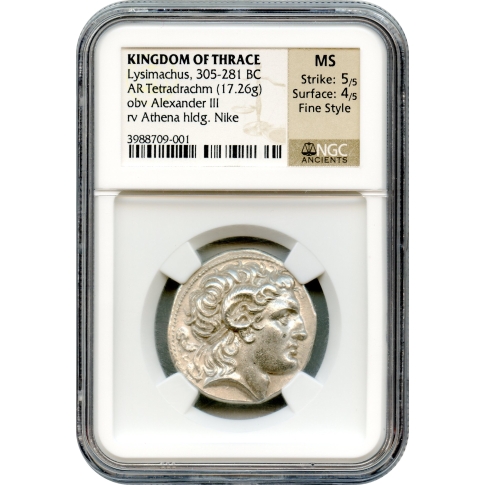Ancient Greece - 305-281 BCE Thracian Kingdom Lysimachus AR Tetradrachm NGC MS Fine Style
THRACIAN KINGDOM. Lysimachus (305-281 BC). AR tetradrachm (30mm, 17.26 gm, 12h). NGC MS 5/5 - 4/5, Fine Style. Pergamum, ca. 287/6-282 BC. Diademed head of deified Alexander III right, with horn of Ammon; K below, dotted border / BAΣIΛEΩΣ / ΛYΣIMAXOY, Athena seated left, Nike crowning royal name in right hand, resting left arm on grounded shield decorated with gorgoneion head boss, transverse spear in background; herm left in outer left field, archaic xoanon (cult image) in inner left field, ΕΠ monogram in exergue. Thompson, Essays Robinson, 220 var. (monogram). Müller 287 (uncertain Thrace).
Alexander the Great's meteoric 13-year career of conquest left the classical world profoundly transformed by the time of his premature death in 323 BC. In the immediate aftermath, Alexander's generals carved up his immense new empire into spheres of influence, although maintaining the fiction of a unified leadership. Territorial disputes soon led to civil wars, with the rival warlords contending for supreme power. Chief among these was Lysimachus, who at various times controlled Thrace, Macedon and much of Asia Minor. For the obverse of his silver his coinage, Lysimachus claimed the mantle of Alexander by choosing the image of the conqueror himself, now shown as a god wearing the ram's horn of the Greco-Egyptian deity Ammon. The image is one of the earliest true portraits to appear on a coin, and one of the finest. The reverse, depicting Athena enthroned, likewise proved extremely influential throughout history, forming the archetype for the figure of Britannia on modern English coins.
| Grading Service | NONE |
|---|---|
| Year of Issue | NONE |
| Grade | NONE |
| Denom Type | N/A |
| Numeric Denomination | AR Tetradrachm |
| Mint Location | NONE |
| Designation | NONE |
| Circ/UnCirc | Not Specified |
| Strike Type | N/A |
| Holder Variety | Strike 5/5; Surface 4/5 struck in Fine Style |
| Grade Add On | NONE |
| Holder Type | N/A |



